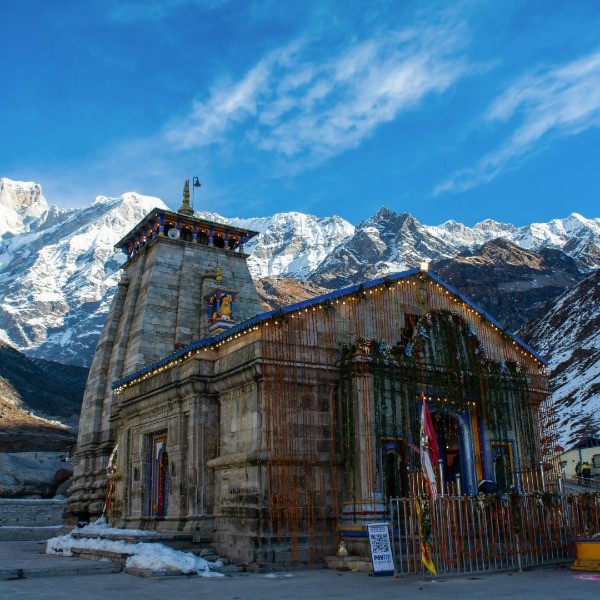 Tucked away in the mighty Garhwal Himalayas at an altitude of 11,755 feet, Kedarnath is more than just a pilgrimage site—it's a living relic of ancient Indian spirituality, endurance, and architectural brilliance. For centuries, this sacred town has attracted sages, devotees, and wanderers alike, drawn by both its divine energy and the raw beauty of its natural surroundings.Reads more : https://www.triptrishul.com/Kedarnath-tour-packageThe roots of Kedarnath stretch deep into the early chapters of Indian mythology and history. According to legend, the temple was built by the Pandavas after the Kurukshetra war, seeking redemption from Lord Shiva for the sins of war and bloodshed. Shiva, unwilling to forgive them easily, is said to have disguised himself as a bull and tried to elude them in the Garhwal region. When discovered, he dived into the ground, leaving his hump behind at Kedarnath—where the temple now stands. The other parts of Shiva’s body appeared in different locations, collectively known as the Panch Kedar.Historically, the current stone structure of Kedarnath Temple is believed to have been constructed by Adi Shankaracharya in the 8th century AD, though the site was likely revered and visited long before that. Built from massive grey stones and set on a glacial plateau, the temple’s construction remains an architectural marvel. It has withstood centuries of harsh weather, snow, and even natural disasters—including the devastating 2013 floods.What’s remarkable is that even after such catastrophes, Kedarnath has continued to stand as a symbol of resilience and faith. The floods caused massive destruction around the region, but the temple itself remained miraculously untouched by the deluge, further deepening its mystical aura.Today, thousands of pilgrims make the arduous trek to Kedarnath each year. The journey isn’t easy—it involves a steep climb through rough terrain and unpredictable weather. But for many, this challenge is part of the spiritual experience. The sound of bells, the scent of incense, and the sight of the snow-capped Kedarnath peak form a memory that stays long after the journey ends.At Trip Trishul, we believe that traveling to Kedarnath is not just a trip—it's a transformation. Whether you're drawn by devotion, curiosity, or a thirst for adventure, this ancient site offers something beyond the ordinary. We ensure that your journey is not just comfortable and safe, but also rich in stories, heritage, and personal discovery.In every stone and trail of Kedarnath lies a tale of gods, time, and unwavering faith. It’s more than history—it’s a feeling. And with Trip Trishul, you're not just visiting a place; you're becoming a part of its story.
Tucked away in the mighty Garhwal Himalayas at an altitude of 11,755 feet, Kedarnath is more than just a pilgrimage site—it's a living relic of ancient Indian spirituality, endurance, and architectural brilliance. For centuries, this sacred town has attracted sages, devotees, and wanderers alike, drawn by both its divine energy and the raw beauty of its natural surroundings.Reads more : https://www.triptrishul.com/Kedarnath-tour-packageThe roots of Kedarnath stretch deep into the early chapters of Indian mythology and history. According to legend, the temple was built by the Pandavas after the Kurukshetra war, seeking redemption from Lord Shiva for the sins of war and bloodshed. Shiva, unwilling to forgive them easily, is said to have disguised himself as a bull and tried to elude them in the Garhwal region. When discovered, he dived into the ground, leaving his hump behind at Kedarnath—where the temple now stands. The other parts of Shiva’s body appeared in different locations, collectively known as the Panch Kedar.Historically, the current stone structure of Kedarnath Temple is believed to have been constructed by Adi Shankaracharya in the 8th century AD, though the site was likely revered and visited long before that. Built from massive grey stones and set on a glacial plateau, the temple’s construction remains an architectural marvel. It has withstood centuries of harsh weather, snow, and even natural disasters—including the devastating 2013 floods.What’s remarkable is that even after such catastrophes, Kedarnath has continued to stand as a symbol of resilience and faith. The floods caused massive destruction around the region, but the temple itself remained miraculously untouched by the deluge, further deepening its mystical aura.Today, thousands of pilgrims make the arduous trek to Kedarnath each year. The journey isn’t easy—it involves a steep climb through rough terrain and unpredictable weather. But for many, this challenge is part of the spiritual experience. The sound of bells, the scent of incense, and the sight of the snow-capped Kedarnath peak form a memory that stays long after the journey ends.At Trip Trishul, we believe that traveling to Kedarnath is not just a trip—it's a transformation. Whether you're drawn by devotion, curiosity, or a thirst for adventure, this ancient site offers something beyond the ordinary. We ensure that your journey is not just comfortable and safe, but also rich in stories, heritage, and personal discovery.In every stone and trail of Kedarnath lies a tale of gods, time, and unwavering faith. It’s more than history—it’s a feeling. And with Trip Trishul, you're not just visiting a place; you're becoming a part of its story.  Tucked away in the mighty Garhwal Himalayas at an altitude of 11,755 feet, Kedarnath is more than just a pilgrimage site—it's a living relic of ancient Indian spirituality, endurance, and architectural brilliance. For centuries, this sacred town has attracted sages, devotees, and wanderers alike, drawn by both its divine energy and the raw beauty of its natural surroundings.Reads more : https://www.triptrishul.com/Kedarnath-tour-packageThe roots of Kedarnath stretch deep into the early chapters of Indian mythology and history. According to legend, the temple was built by the Pandavas after the Kurukshetra war, seeking redemption from Lord Shiva for the sins of war and bloodshed. Shiva, unwilling to forgive them easily, is said to have disguised himself as a bull and tried to elude them in the Garhwal region. When discovered, he dived into the ground, leaving his hump behind at Kedarnath—where the temple now stands. The other parts of Shiva’s body appeared in different locations, collectively known as the Panch Kedar.Historically, the current stone structure of Kedarnath Temple is believed to have been constructed by Adi Shankaracharya in the 8th century AD, though the site was likely revered and visited long before that. Built from massive grey stones and set on a glacial plateau, the temple’s construction remains an architectural marvel. It has withstood centuries of harsh weather, snow, and even natural disasters—including the devastating 2013 floods.What’s remarkable is that even after such catastrophes, Kedarnath has continued to stand as a symbol of resilience and faith. The floods caused massive destruction around the region, but the temple itself remained miraculously untouched by the deluge, further deepening its mystical aura.Today, thousands of pilgrims make the arduous trek to Kedarnath each year. The journey isn’t easy—it involves a steep climb through rough terrain and unpredictable weather. But for many, this challenge is part of the spiritual experience. The sound of bells, the scent of incense, and the sight of the snow-capped Kedarnath peak form a memory that stays long after the journey ends.At Trip Trishul, we believe that traveling to Kedarnath is not just a trip—it's a transformation. Whether you're drawn by devotion, curiosity, or a thirst for adventure, this ancient site offers something beyond the ordinary. We ensure that your journey is not just comfortable and safe, but also rich in stories, heritage, and personal discovery.In every stone and trail of Kedarnath lies a tale of gods, time, and unwavering faith. It’s more than history—it’s a feeling. And with Trip Trishul, you're not just visiting a place; you're becoming a part of its story.
Tucked away in the mighty Garhwal Himalayas at an altitude of 11,755 feet, Kedarnath is more than just a pilgrimage site—it's a living relic of ancient Indian spirituality, endurance, and architectural brilliance. For centuries, this sacred town has attracted sages, devotees, and wanderers alike, drawn by both its divine energy and the raw beauty of its natural surroundings.Reads more : https://www.triptrishul.com/Kedarnath-tour-packageThe roots of Kedarnath stretch deep into the early chapters of Indian mythology and history. According to legend, the temple was built by the Pandavas after the Kurukshetra war, seeking redemption from Lord Shiva for the sins of war and bloodshed. Shiva, unwilling to forgive them easily, is said to have disguised himself as a bull and tried to elude them in the Garhwal region. When discovered, he dived into the ground, leaving his hump behind at Kedarnath—where the temple now stands. The other parts of Shiva’s body appeared in different locations, collectively known as the Panch Kedar.Historically, the current stone structure of Kedarnath Temple is believed to have been constructed by Adi Shankaracharya in the 8th century AD, though the site was likely revered and visited long before that. Built from massive grey stones and set on a glacial plateau, the temple’s construction remains an architectural marvel. It has withstood centuries of harsh weather, snow, and even natural disasters—including the devastating 2013 floods.What’s remarkable is that even after such catastrophes, Kedarnath has continued to stand as a symbol of resilience and faith. The floods caused massive destruction around the region, but the temple itself remained miraculously untouched by the deluge, further deepening its mystical aura.Today, thousands of pilgrims make the arduous trek to Kedarnath each year. The journey isn’t easy—it involves a steep climb through rough terrain and unpredictable weather. But for many, this challenge is part of the spiritual experience. The sound of bells, the scent of incense, and the sight of the snow-capped Kedarnath peak form a memory that stays long after the journey ends.At Trip Trishul, we believe that traveling to Kedarnath is not just a trip—it's a transformation. Whether you're drawn by devotion, curiosity, or a thirst for adventure, this ancient site offers something beyond the ordinary. We ensure that your journey is not just comfortable and safe, but also rich in stories, heritage, and personal discovery.In every stone and trail of Kedarnath lies a tale of gods, time, and unwavering faith. It’s more than history—it’s a feeling. And with Trip Trishul, you're not just visiting a place; you're becoming a part of its story. Fri, 22 August 25 : 5:08 : Trip Trishul
Visit / Join Group to Reply


